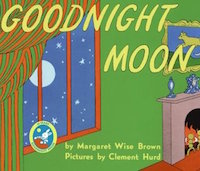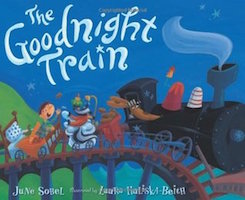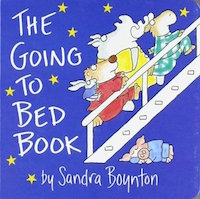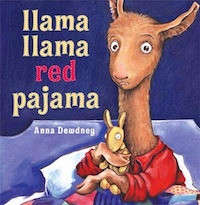Fairy Tales & Fables Part 1: Little Red Riding Hood, The Three Billy Goats Gruff, & The Three Little Pigs
There are so many reasons for parents to read fairy tales and fables to young

Reading to a child every day isn’t just about promoting literacy or getting bonding time, it’s also about flexing the storytelling muscle.
Stories are really, really important--they are how we give an otherwise chaotic world meaning. It's the difference between observing and inferring: Grandma is making tea vs. Grandma must be sad; she's making tea. It's also the difference between sequencing and expressing causality: Grandma is sad. Grandma is making tea. vs. Grandma is sad, so she's making tea to feel better.
There is an emerging body of research on the relationship between narrative skills and autism, and we know that kids with ASD have deficits in this area.1 A number of studies suggest that reading fiction (but not nonfiction) develops empathy and theory of mind skills.2 This is an emerging area of research, but it seems logical. When we read fiction we practice adopting another's point of view.
But for a child on the spectrum, attending to an adult reading a story can be really difficult. And being read to in a peer group, a skill which a child must master in order learn in a less restrictive classroom environment, is even harder. With my twins, I’m lucky to have a built-in peer dyad, but in the absence of a suitable sibling, attending a kids' story hour at your branch library, or maybe even at a local children’s bookstore, can be a good option for getting the social reading practice your child needs.3
In the home, it's a good idea to find a consistent time of day to ritualize reading. Luke and Harry know that we will read 4+ books every night before bed, and keeping to this regular routine means that things go more smoothly. Bedtime is the most manageable time of day for most families to read together, and that's why the 'bedtime story' is such a huge children's lit sub-genre. While I personally believe that any book your kids enjoy can be read at bedtime, there are some purpose-made bedtime story gems out there. Here are four of our favorites:

I know, I know, I’m treading some super-revolutionary ground here.
Like many, we've been reading this book to our kids since their birth and this lifelong familiarity is undoubtedly a critical factor in its staying power. But no matter when you come to it, "Goodnight Moon" is work of genius, and I was not the least bit surprised to learn that it took Brown over two years to polish her initial draft. It's so well done that you don't even realize how perfect it is:
In the great green room
There was a telephone
And a red balloon
And a picture of --
The cow jumping over the moon
The simple rhyme and easy rhythm help the child anchor themselves in the text. The airy pacing, so well timed for hovering on a page, gives a reader like me who wants to add a sound effect embellishment, the space to do so: In the great, green room / There was a telephone RING! RING! And a red balloon / And a picture of -- / The cow jumping over the moon MOO!
The frame zooms in and out, showing us socks drying on a laundry line as well as the stars outside a window. It's a good opportunity to practice that great 'Where's Waldo' skill of scanning, which Lily, our boys' OT, tells us is good input for a hyposensitive visual stimmer like Harry. Lots of books designed for scanning (of the "I Spy" variety, for instance) can be too chaotic; not this one.
"Goodnight Moon" doesn't have a true story, but it's still a fictional world. The text explores a child character's ritual set to poetry--an anthropomorphized baby bunny's bedtime ritual, to be specific. My favorite moment happens when we say goodnight to "nobody" and are treated to a mysterious, blank page. It can be read so many ways, and it is this tiny imaginative challenge that is so subtle and appropriate for a child who needs lots of practice with abstract ideas.

"The Goodnight Train" is Luke's favorite bedtime book. And it is so preferred that I can use it as an opportunity to practice his verbal manding. "I--want--Goodnight--Train--please," he says, with perfect eye contact.
After I read it to him, Luke usually wants a turn to "read" it to me. Normally, when he knows a text well, he scripts like mad--in the non-functional, automatic sense of wandering around the apartment talking to himself.
This is completely different. He holds the book so I can see, turns the pages in a decently close approximation of his memorized performance, and, rocking his joint attention skills, uses eye contact to check in and make sure I'm listening and enjoying. Because he's so excited about doing this, his articulation of the text has steadily improved; he really wants to get it right. Poor articulation is one of Luke's biggest communication barriers, so this is huge. The whole thing is heart-bursting, happy-cry-inducing kind of stuff.
Hooray for the formula of train book + bedtime story. It must have made for a sweet book pitch. But the magic here is much more than any formula. This book is special.
The goodnight train gets ready for its journey, leaves the station, accelerates to the climax of the book, and then, tiredly, slows down and turns in for the night. In the execution of this, using pitch-perfect word choice and subtle changes in rhythmic emphasis, Sobel achieves precisely what a bedtime book is supposed to: capture our attention in a dynamic and exciting way, and build to a sleepy denouement. As her appealing train meanders through bright and cleverly drawn landscapes, there is real skill with how she makes the reader feel the pace, the train's change in speed. Take this early passage depicting the moment the train begins to accelerate:
Slumber, lumber up the hill.
Cars climb slowly up until...
Roll the corner, rock the curve.
Blankets bounce with every swerve.
Rock-a Rock-a Rock-a Rock-a Shhhh! Shhhh!
This sense of movement is just infectious to read aloud. And the train sounds built into the text every few pages are both well-spelled phonetically (for the train-sound novices of the world) and also just super-clever. You can't help but appreciate the artistry in combining recognizable train sounds with sleepy time theming. Respect.

"The Going-To-Bed Book" is the closest thing to a successful bedtime social story that I've found, although the story oddly takes place on a boat. The animals go below deck to take a bath, hang up their towels, change into PJs, and brush their teeth. In a fun twist, they go above deck to do some moonlit exercising, then they turn off the lights and let the ocean waves rock them to sleep.
My kids have a particular love affair with Sandra Boynton, but I suspect this may be fairly universal. Her signature--the googly eyed cartoon animals, the small-scale square board book design, and her hand-drawn font--is instantly recognizable and puts children at ease.
Read straight, this isn't her best book. But my wife Janet and I found it surprisingly ripe for end-of-the-day sensory integration. Riffing off of the weird physical comedy of animals exercising on a ship deck before hitting the sack, we developed a number of physical routines. We rub the kids' backs and tummies when the animals bathe ("SCRUB SCRUB SCRUB!"). We hand-over-hand a simulation of teeth brushing ("They brush and brush and brush their teeth."). And when the animals exercise we bend and stretch our kids' arms and legs, which they find hilarious, but which also gives them some pretty great proprioceptive input. At the end of the book ("The moon is high. The sea is deep. / They rock / and rock / and rock / to sleep."), we lift our giant 3-year-olds and rock them exaggeratedly to really get the vestibular input going, and, as a finale, toss them into their beds, which often produces a delighted squeal (and requests for an encore read).
All this sensory input is good for our kids, and while parents of typical children might shy away from so much physicality "riling them up before bed," parents of kids with sensory processing disorders know that kids who need this kind of input will do everything better--including sleep--when their needs are met.
As I said, there's nothing organic about "The Going-To-Bed Book" that makes it a sensory book, but it's an example of a book that allows for this kind of approach.

Harry's ABA therapist Marigold brought a copy of "Llama Llama Red Pajama" to our apartment a few months ago and we've been borrowing it ever since. At the moment, both boys are at different stages in an ABA program where they are learning to label emotions based on pictures of people with highly exaggerated facial expressions. This book is the cartoon llama version of that program.
The plot is easy to follow. Mama Llama reads Baby Llama a bedtime story, kisses him goodnight, and goes downstairs to do the dishes and chat on the phone. Baby Llama, of course, starts to feel lonely and calls out for a drink, then gets impatient when Mama Llama doesn't come back right away. He gets sad and starts crying, then angry and starts stomping. Then he worries that she might never come back, and starts screaming in fear. Mama Llama races upstairs and explains that mama always comes back, and that he needs to learn to be patient. Obviously, it ends with kisses and a certain sleepy llama falling asleep.
The text rhymes, has a tight structure, and is highly repetitive. Each verse begins with the words "Llama llama red pajama" so the child always can anticipate the action. Emotional moments are individually explored in their own complete verse, so you don't have to worry about stopping to ask a child, "How does Baby Llama feel now?" It won't throw things off. This is a book that is easy to stop and start.
Luke doesn't care for it, and I think that's because he's not ready to follow a plot based on a character's changing emotional state (and its causality). For Harry, the fact that the point of view character is a child and the situation is familiar has made the difference. Eventually, I think it will be a good book for Luke too.
Goodnight Moon
by Margaret Wise Brown and Illustrator Clement Hurd (HarperFestival)
$8.99 USD, board book edition
What we love: Lots of repetitive syntax (sentences starting with "Goodnight...", etc.); great rhythm and easy rhyme scheme; well-paced with room to ad-lib; encourages abstract thinking; illustrations work for scanning.
Challenges: Illustrations are high contrast (which is difficult for some kids with ASD); old fashioned elements (like a 40s era telephone) won't be familiar and may even confuse a child still learning to tact their modern counterparts.
The Goodnight Train
by June Sobel and Illustrator Laura Huliska-Beith (HMH Books for Young Readers)
$7.99 USD, board book edition
What we love: Trains; text includes high-interest train sound effects that are well scripted; good rhyme scheme and rhythm; the structure really makes sense for bedtime.
Challenges: Illustrations are gorgeous, but there's a lot going on and it may be too much for some kids to track.
The Going to Bed Book
by Sandra Boynton (Little Simon)
$5.99 USD, board book edition
What we love: It's very short; an actual bedtime social story; familiar styling of Sandra Boynton books breeds comfort; simple and funny; great opportunities for integrating proprioceptive, vestibular, and deep pressure sensory moments.
Challenges: Lots of people really can't get past a bedtime ritual book that takes place on a boat and involves exercising (and I guess the joke may be lost on a child who takes things very literally); the boat has a Noah's Ark feel to it (but the story doesn't go there); and finally, it misses a key element in the bedtime ritual--reading.
Llama, Llama, Red Pajama
by Anna Dewdney (Viking)
$17.99 USD, hardcover edition
What we love: Lots of repetition; animal character; good for practice recognizing emotions from facial expressions; opportunities for exploration of the causality of emotion in a highly relatable situation.
Challenges: Too expensive; "Llama llama red pajama" is a bit of a tongue-twister; it's a "mama" book (so not the best choice for kids with a single father or two dads).
1. Research has shown that children with autism have deficits in receptively understanding meaningful elements of narrative. One such study, "The Frog Ate the Bug and Made his Mouth Sad” was published in April 2000 in The Journal of Abnormal Child Psychology. It found that children with autism were less likely to show emotional understanding of the characters in a story. Other more recent studies, like Constructing fictional stories: A study of story narratives by children with autistic spectrum disorder, which was published in the journal Research in Developmental Disabilities in October 2014, seem to confirm these findings elaborating that children with autism have trouble constructing longer stories with causal elements.↩
2. Recent scholarship has consistently found relationships between reading fiction and empathy (Exploring the link between reading fiction and empathy: Ruling out individual differences and examining outcomes, published January 2009 in The European Journal of Communication Research) and theory of mind skills (Reading Literary Fiction Improves Theory of Mind, published in October 2013 in Science). One study published in October 2006 in The Journal of Research in Personality, Bookworms versus nerds: Exposure to fiction versus non-fiction, divergent associations with social ability, and the simulation of fictional social worlds, actually concludes that while reading fiction regularly was a positive predictor for empathy/social-acumen skills, reading lots of nonfiction was a negative predictor for the same.↩
3. Something to remember about libraries and bookstores is that they often don't understand how to accommodate a child with autism. A common scenario is a child who can’t yet sit and attend to the book and is "disruptive" when made to do so. Most parents using a behavioral approach will want to stay the course so as not to reinforce any escape-driven problem behaviors. Sadly, as you probably already know, when you hold a child down, people often stare, accuse you of cruelty, or complain that your family's presence is a nuisance. Why don't you take a walk so he can calm down? they'll likely suggest. Obviously, a child who screams the entire time probably needs more practice sitting in a familiar environment or to have the library/bookstore itself conditioned first. Don't place unrealistic demands on your children, and think about ways to reinforce their hard work that you can use in this setting (the right librarian might be willing to let you pop a gummy bear in your kid's mouth, you never know until you ask). You might also consider a "backwards chain" approach, having your child attend the end of storytime and then slowly increase the demand you place as your child can tolerate it. Whatever you do, it's really, really important not to compromise your child’s behavioral intervention plan, so it’s a good idea to approach the event organizer in advance and make your needs perfectly understood.↩